
THE HANDSTAND
june 2005
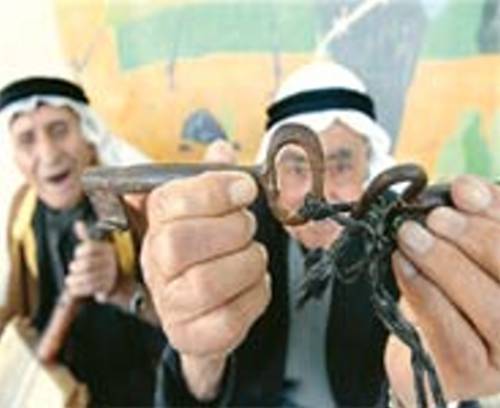
Nakba Day marked by
pilgrimage to abandoned Israeli Arab villages
George Bisharat(Palestine Chronicle);
"Fifty-seven years
ago today, as one nation was created, another was
destroyed. By Israel's Independence Day May 14,
1948 hundreds of thousands of Palestinians had
already fled or were forced into exile by Israeli troops
in a coordinated plan that has been well documented.
The Palestinians' only fault was that they were not
Jewish and, by their presence and predominant ownership
of the land, were obstacles to the creation of a Jewish
state.
The catastrophe or "Nakba," as it is
called by Palestinians eventually swept more than
700,000 Palestinians from their homes and homeland. That
is the history of the establishment of Israel that is
often forgotten in the United States but is stubbornly
remembered by Palestinians.
Why do Palestinians who lost their homes, and who have
been barred by Israel from returning ever since, remember
their pre-exile lives with such enduring intensity? What
does it signify that this tradition of remembering has
now been transmitted to generations of Palestinians who
were born in exile and have known their old homes and
villages only from yellowed and crumbling photographs,
like shadows left by a passing sun? "
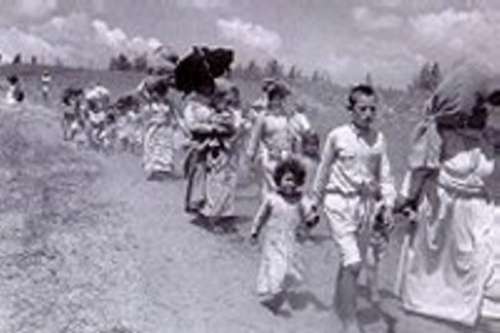
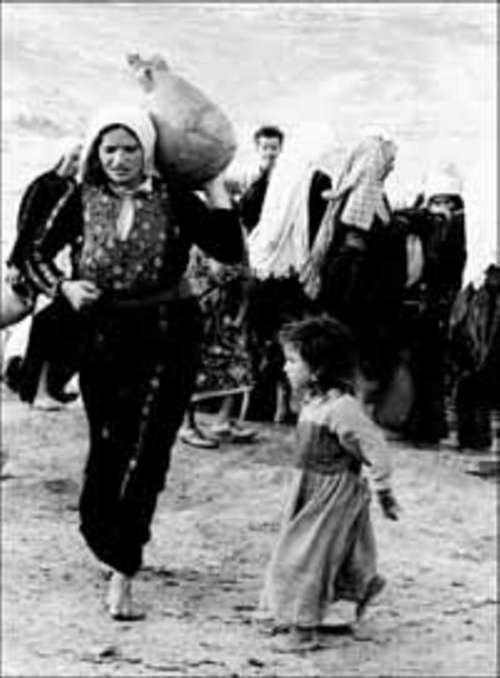
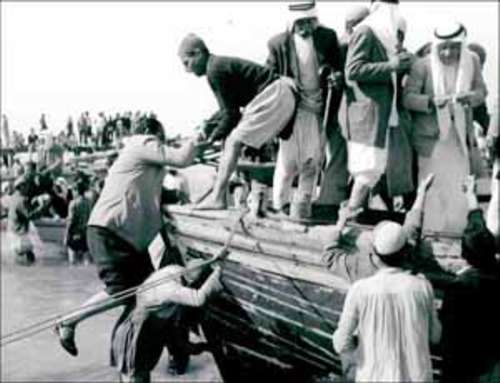
By Yoav Stern, Haaretz Correspondent
The Palestinian Nakba
("Catastrophe") Day, which commemorates the
establishment of Israel in 1948, was marked Thursday by
mass pilgrimages to abandoned Palestinian villages. In
the morning, families of internally displaced
Palestinians visited the sites of the villages that they
left or from which they were expelled in 1948. In the
afternoon, 5,000 people held a rally at the site of
Khirbet Husha and Khirbet Ksair near Kibbutz Usha in the
Galilee.
The rally was organized by the Committee for the Defense
of the Rights of the Internally Displaced together with
other Arab organizations and leaders and a few Jewish
organizations. It began with a procession on the lands of
the abandoned village of Husha, a tour of the cemetery
and the ruins of homes. Both Husha and Ksair were
abandoned in April 1948, after harsh battles between the
Israeli forces and Arab militias.
Awareness of these sites has been growing among the Arab
public, as manifested in organized tours to the sites and
the preservation of churches and mosques which remained
standing. More than 250,000 internally displaced people
live in Israel, many only a few minutes drive from the
villages from which their families came.
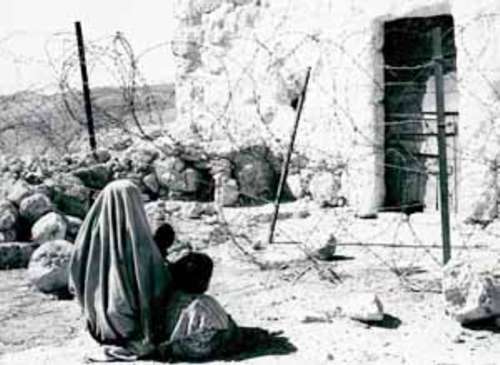
Daud Bader, secretary of the Committee for
the Rights of the Internally Displaced, said Thursday
that activities involving the abandoned villages began in
the 1990s. "The internally displaced in Israel
thought someone would act on their behalf, but were
disappointed. Young people who began to develop political
consciousness took the initiative, and local committees
sprouted up in different villages," he said.
Among the speakers at Thursday's rally were Shawki
Khatib, chairman of the Higher Arab Monitoring Committee,
Wakim Wakim of the Committee for the Rights of the
Internally Displaced, and a representative of the village
of Husha, Musa Zrair. Several MKs also attended,
including Mohammad Barakeh, the only member of
parliament who comes from a displaced family.
Some of the participants at the rally arrived from the
center of the country on a bus bearing the symbolic
number 194, the number of the UN resolution dealing with
the Palestinians' "right of return." The
bus ride was organized by Zochrot, an organization
dedicated to educating the Israeli public about the
state's wrong-doings against the Palestinians. Several
weeks ago, Zochrot commemorated the massacre perpetrated
by Jewish fighters in 1948 in the village of Deir Yassin,
near Jerusalem.
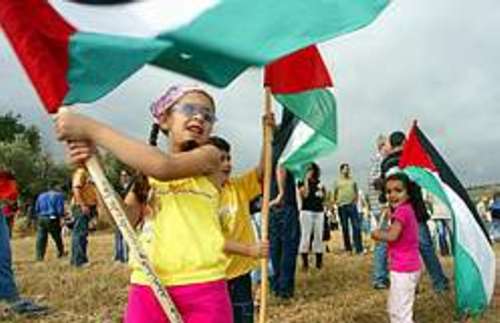
* * * * * * * * * * * * * *
GAZA
Al-Shati’
Refugee Camp Grim Reminder of Nakba
By Olla Attallah, IOL Correspondent
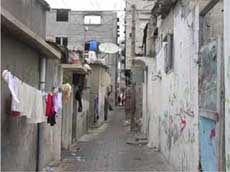 GAZA CITY, May 15, 2005
(IslamOnline.net) – Packed like sardines and living
under appalling conditions, Palestinians in
Al-Shati’ camp are a living example of
Palestinians’ sufferings 57 years after their
homeland was usurped by Zionists and the state of Israel
declared on the rubble of Palestine, a sad chapter in
Arab and Islamic history known as the Nakba Day. The
800-square-meter camp is one of the poorest and most
crowded in the Gaza Strip with no shinning sun, nor fresh
air as houses are glued to one another and children
unmistakably recognizable with their tattered clothes and
anemic bodies.
GAZA CITY, May 15, 2005
(IslamOnline.net) – Packed like sardines and living
under appalling conditions, Palestinians in
Al-Shati’ camp are a living example of
Palestinians’ sufferings 57 years after their
homeland was usurped by Zionists and the state of Israel
declared on the rubble of Palestine, a sad chapter in
Arab and Islamic history known as the Nakba Day. The
800-square-meter camp is one of the poorest and most
crowded in the Gaza Strip with no shinning sun, nor fresh
air as houses are glued to one another and children
unmistakably recognizable with their tattered clothes and
anemic bodies.
Abdel Rahman Al-Adal, 71, recalled how Zionist gangs stormed his village and killed his next of kin in cold blood. “I was 14 when Jews attacked and imposed a tight blockade on Barir village on May 14, 1948, leaving us with no option but to flee or be massacred,” he told IslamOnline.net. “They lined up my three cousins and many others of the village’s youths against the wall and shot them dead.” Fighting back his tears, Al-Adal remembered how everything in his village was covered in blood. “I saw hundreds of corpses lying on the streets and my father told me at the time that up to 110 villagers were slain by the Zionists.” He recalled that despite the merciless attacks by the Zionists, the villagers displayed gallantry in defending their land till the last breath. “When they took refuge in the neighboring village of Halikat the Zionist gangs stepped up attacks, and kept hunting them down from one village to another,” Al-Adal said.
On April 18, 1948, Palestinian Tiberius was captured by Menachem Begin's Irgun group, putting its 5,500 Palestinian residents in flight. On April 22, Haifa fell to the Zionist mobs and 70,000 Palestinians fled. On April 25, Irgun began bombarding civilian sectors of the Palestinian city of Jaffa - the largest city in Palestine at that time, terrifying the 750,000 inhabitants into panicky flight. On May 14, the day before the creation of Israel on the rubble of Palestine and bodies of the Palestinians, Jaffa completely surrendered to the much better-equipped Zionist gangs and only about 4,500 of its population remained.
Appalling Conditions
Al-Adal can barely remember the faces of some of his relatives as fled to neighboring countries, tent cities and refugee camps. Some of them have even disappeared for ever. “My family and I moved along with other refugees to Gaza’s Al-Shujaiya district, then Al-Nusseirat tent city and finally we settled at Al-Shati’ refugee camp.” On the life in the camp, Al-Adal said it is a mixture of bitterness and suffering. “With undrinkable water and persistent power outages, we truly live under appalling conditions in the camp,” he lamented. The camp accommodated in 1949 some 23,000 refugees but is now home to 78,000, according to UNRWA estimates.
Return Dream
Like thousands of Palestinian
refugees across the globe, Hadia Salem, a 73-year-old  camp resident, has been dreaming of
returning home. “Now our lives are getting from
worse to worst in Al-Shati’ camp,” she told
IOL. “I still remember how I used to go with my
father to reap wheat fields in our village when I was 16.
“All of a sudden, my life turned upside down when
the Zionists attacked our home, killed my father,
devastated our land and marauded our property,” she
recalled. Salem, who lost all her family members to
Zionist attacks, is sure that one day she will return
home. “If I don’t, my grandchildren will sure
do,” she said emphatically.
camp resident, has been dreaming of
returning home. “Now our lives are getting from
worse to worst in Al-Shati’ camp,” she told
IOL. “I still remember how I used to go with my
father to reap wheat fields in our village when I was 16.
“All of a sudden, my life turned upside down when
the Zionists attacked our home, killed my father,
devastated our land and marauded our property,” she
recalled. Salem, who lost all her family members to
Zionist attacks, is sure that one day she will return
home. “If I don’t, my grandchildren will sure
do,” she said emphatically.
Palestinian refugees in the Gaza
Strip are estimated at 878,000, living in eight refugee
camps: Jabaliya, Rafah, Al-Shati’, Al-Nusirat,
Al-Boureij, Khan Yunis, Al-Maghazi and Deir Al-Balah.
Last year, Al-Aqsa Society for the Reconstruction of
Islamic Shrines (ASRIS) warned in a report that an
Israeli plan called “Tamam-6” was aimed at obliterating the Islamic and Arab character of
Palestinian villages occupied in 1948 by marking out
mosques, tombs and historical sites. The scheme will see
new parks, bridges, roads and sewerage system running
deep into many Islamic and Arab historical sites. In a
counter effort, the first Palestinian atlas was recently launched to
document for the generations to come territories usurped
and occupied by Israeli troops and keep the cause vivid.
Up to 50,000 maps charting Palestinian sites that date back to 1799 are found in the English-language geographical encyclopedia.